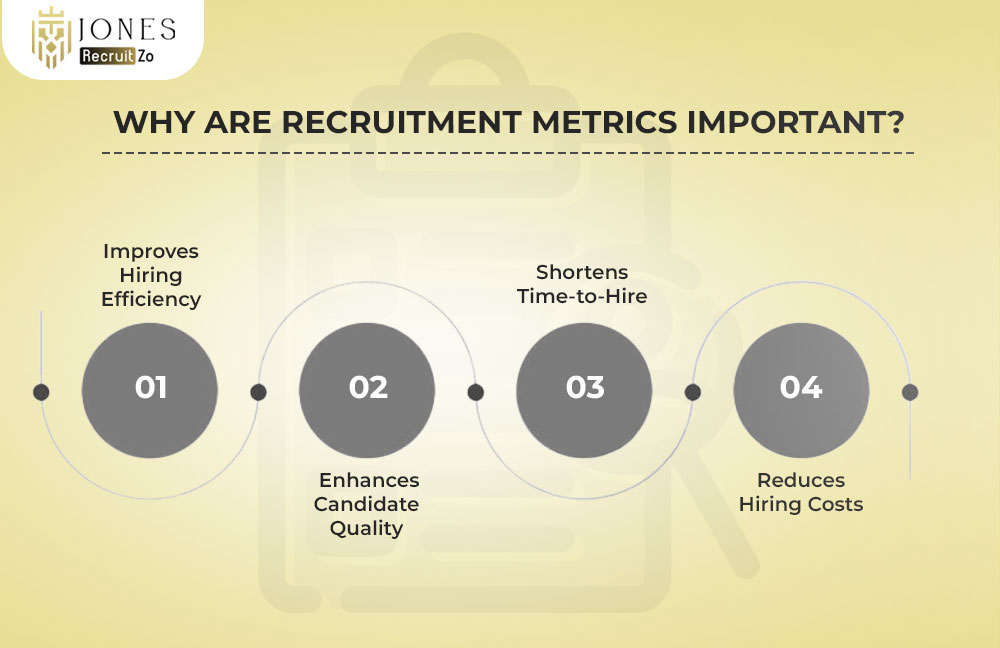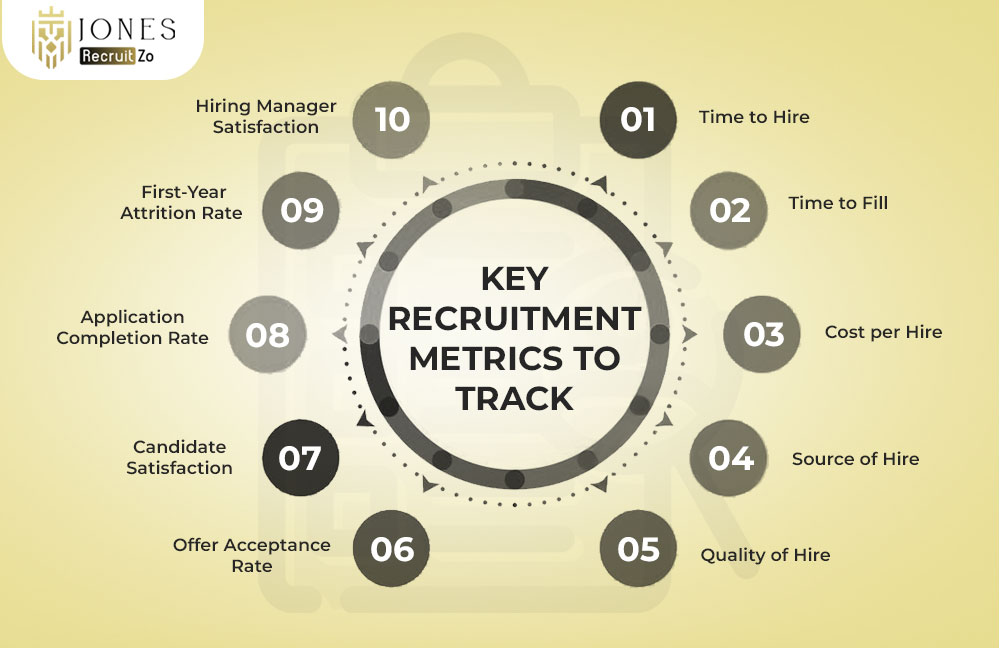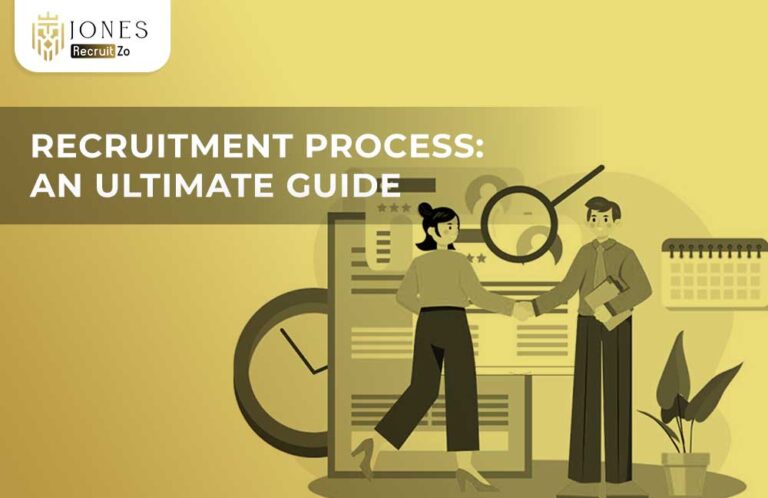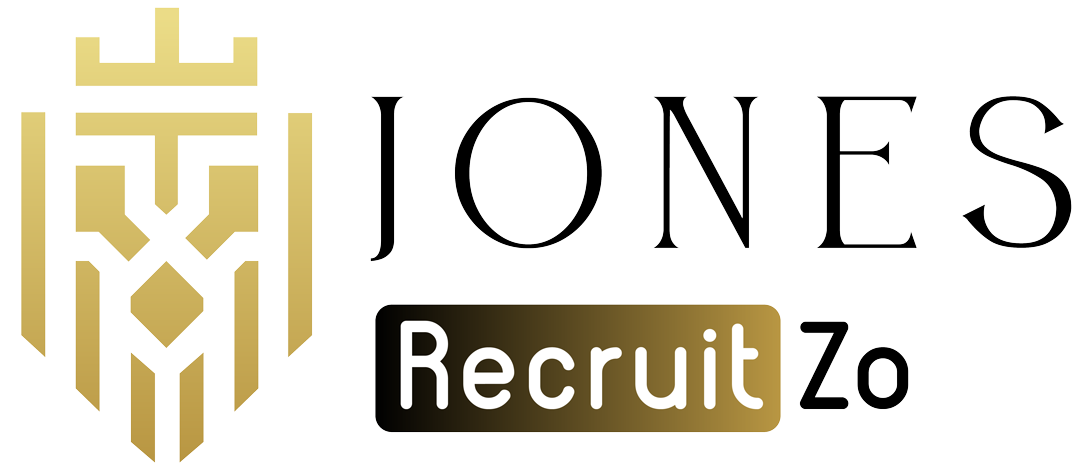What are Recruitment Metrics?
The recruitment metrics are the key performance indicators that assist in the measurement and appraisal of the effectiveness of the hiring process. These data points will provide some insight into the alignment of the recruitment programs with the strategic objectives of the company so that teams can maximise performance and decision-making.
Why Are Recruitment Metrics Important?

The recruitment metrics ensure that one can have data-based insights to quantify the effectiveness of the hiring process in organisations so that they can optimise strategies, decision-making, and candidate experience. They help teams to monitor progress and eliminate waste.
Improves Hiring Efficiency
By incorporating recruitment metrics within HR, one could improve efficiency by highlighting the areas that are working or not. Keeping an eye on such critical indicators as cost-per-hire and time-to-fill, HR teams will be able to narrow down on strategies that will allow attracting the right candidates in a shorter period, which will positively affect the outcome of recruiting metrics as a whole.
Enhances Candidate Quality
Recruitment measures enable companies to measure the fit between people hired and the job requirements after hire. These are used to streamline the recruiting process, resulting in a closer job-person fit, and the net effect is increased quality and retention of the newly hired employees.
Shortens Time-to-Hire
Declaring a reduction in time-to-hire cuts down costs and helps ensure the fast hiring of talent. The metrics of recruitment without time-to-hire are what? It is an essential metric that shows lags or effectiveness in candidate flow in a recruitment funnel between application and acceptance.
Reduces Hiring Costs
The recruitment metrics will enable saving costs as they illuminate the areas that require many resources. Businesses can determine how to make savings or how not to waste money. Metrics tools in HR, like cost-per-hire, can be used to budget future positions as well as enhance returns on the investments in recruiting.
Key Recruitment Metrics to Track

The key recruitment measures would be time-to-hire, cost-per-hire, quality of hire, and source of hire. Such measures can be used to monitor, gauge, and enhance recruitment and guarantee higher efficiency, budget management, and talent acquisition effectiveness.
Time To Hire
The time to hire is an essential recruitment key performance indicator used to monitor the rate at which applicants to the firm become employees. It indicates the agility of the recruitment process and is highly instrumental in improving the experience of both the hiring party and the candidate.
Time To Fill
Time to fill is a measurement of the recruitment process and checks the time taken to fill the job after posting until final acceptance. It offers invaluable information in terms of the number of talents available and the efficiency of the recruiting measures provided at the sourcing and assessment stages.
Cost Per Hire
Cost per hire takes into consideration the total dollar cost of making a hire. This measure of recruitment entails advertisement, recruiter expenses, and induction expenses. Knowledge of CPH can make it easier to quantify the ROI of recruitment and can help to better plan and budget the workforce.
Source of Hire
Source of hire is one of the potent recruitment metrics to monitor which platforms provide quality candidates. Information provided by SoH helps recruiters to know where to allocate advertising dollars and gear the better agency in terms of improved efficiency.
Quality of Hire
The recruitment measure is the contribution that a new recruit can bring to an organisation. It evaluates performance, longevity, and retention. Integrating recruiting metrics in the organisation will enable the organisation to make small adjustments in the selection of candidates and the overall effectiveness of the organisation in the long run.
Offer Acceptance Rate
Offer acceptance rate is useful in measuring the levels of attraction by an offer from a company. A low acceptance rate may indicate a problem in culture or pay. This measure of recruitment is critical to the process of job offer enhancement and improving the hiring experience.
Candidate Satisfaction
This measure of recruitment is the perception of applicants towards the hiring process. The received feedback is beneficial in improving the communication, openness, and interviewing that lead to a better employer brand and higher chances of hiring top-level talent.
Application Completion Rate
Application Completion Rate is used to measure the extent to which candidates fill out and send job applications. It is an indication of recruitment in which the technical or design issues in your application process can be identified and corrected by HR in streamlining the processes and enhancing the user experience.
First-Year Attrition Rate
The first-year attrition rate captures premature exits, and it can be used to trace the success of hiring decisions. This recruitment measure will help reveal flaws in a hiring process or job compatibility so that no candidate who would not suit the company and its policies would be hired again in the future.
Hiring Manager Satisfaction
Hiring manager satisfaction is also another useful measure of recruitment, which indicates the effectiveness of the talent acquisition department in meeting the internal demands. It makes the hiring process provide people who will be able to fit into the job as well as fit into teams.
FAQs
1) What are Recruitment Metrics?
The recruitment metrics are the key performance indicators that assist in the measurement and appraisal of the effectiveness of the hiring process. These data points will provide some insight into the alignment of the recruitment programs with the strategic objectives of the company so that teams can maximise performance and decision-making.
2) Why Are Recruitment Metrics Important?
The recruitment metrics ensure that one can have data-based insights to quantify the effectiveness of the hiring process in organisations so that they can optimise strategies, decision-making, and candidate experience. They help teams to monitor progress and eliminate waste.
3) What are the key recruitment metrics?
The key recruitment measures would be time-to-hire, cost-per-hire, quality of hire, and source of hire. Such measures can be used to monitor, gauge, and enhance recruitment and guarantee higher efficiency, budget management, and talent acquisition effectiveness.
4) How can the cost per hire be reduced?
In order to lower the cost of hire, you must do the following: streamline your hiring procedure, take advantage of low-budget sourcing channels, automate routine activities, and enhance referral initiatives. Monitor recruitment metrics frequently to remove unneeded costs and process waste.
5) What is Time to Hire?
Time to hire is a metric that shows the rate at which candidates are hired as employees and is indicative of the agility of the recruitment process, and improves the candidate and employer experience of the hiring process.
6) What is the Time to Fill?
Time to fill measures the efficiency of the recruiting process and demonstrates talent supply time as well as the time it takes to fill a position, starting with the job posting and going through to acceptance.
7) What is Cost Per Hire?
The cost per hire metric takes the overall costs of recruiting, as well as advertising and hiring costs, and it assists organisations to determine the ROI of hiring, as well as to enhance workforce budgeting.
8) What is the source of hire?
Source of Hire shows the sources that provide the best candidates, helping recruiters decide how to spend their money and select the best channels to increase hiring effectiveness.
9) What is Quality of Hire?
Quality of Hire assesses the increment of a recruit in terms of performance, retention, and tenure to enhance selection and organisational efficiency as a whole.
10) What is the Offer Acceptance Rate?
Offer acceptance rate indicates the frequency with which offers are accepted by applicants and reflects the attractiveness of companies, and assists in enhancing job offer techniques and employer branding.
11) What is Candidate Satisfaction?
Candidate satisfaction measures the experience of the applicant in the hiring process and, based on this feedback, improves communication, transparency, and reputation as an employer.
12) What is Application Completion Rate?
Application Completion Rate reveals the number of individuals who finish applications, identifies the technical problems, and increases the usability and process performance.
13) What is the first-year attrition rate?
First-Year Attrition Rate monitors the highly in-demand entity of early employee turnover, which can pinpoint wrong hires and enhance the subsequent recruiting approach and employment-job fit.
14) What is Hiring Manager Satisfaction?
Hiring manager satisfaction is a measure of recruitment responsiveness to internal requirements to make sure that those who are hired suit not only the job they are taking but also fit the team.














